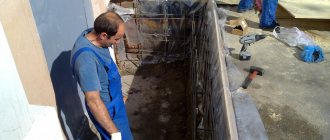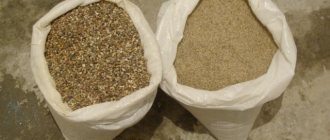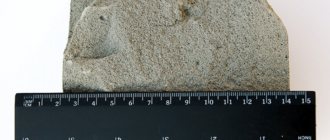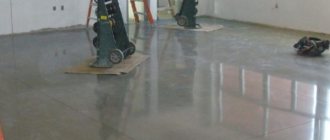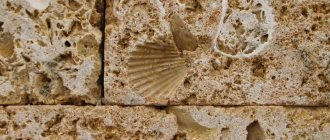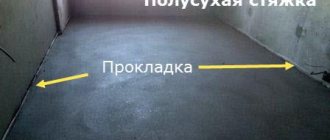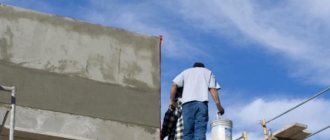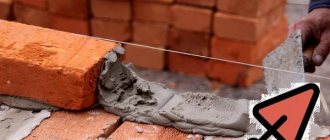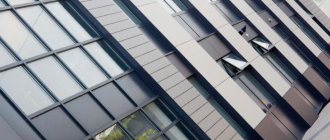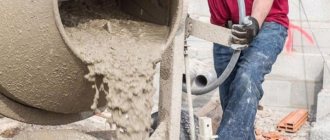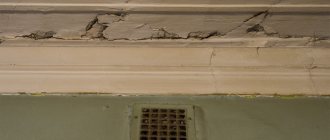General provisions
Sawdust concrete was invented back in the sixties of the last century in the Soviet Union as a new type of lightweight low-density concrete. Passed all the necessary tests and was standardized. And already in the nineties, due to the urgent need of the population to save money, it gained wide popularity.
Advantages
- Environmental friendliness . Only natural ingredients are used in production, a list of which we will consider in more detail below.
- Fire resistance . Fire safety can play the most important role in some cases.
- Lack of hydrophobicity . There is no tendency to the spread of rotting or corrosion.
- High strength of concrete products . You can be quite confident in the sufficient reliability of the future construction. Just like cutting reinforced concrete with diamond wheels, processing sawdust concrete requires the use of diamond attachments.
Diamond drilling of holes in sawdust-based concrete
- Vapor permeability . Helps create an ideal indoor microclimate.
- Low thermal conductivity . This is achieved precisely due to the presence of sawdust in the structure.
- Frost resistance . Tolerates the low temperatures of our harsh winters without harmful consequences.
Photo of a two-story sawdust concrete house in winter
- Relatively light weight . For example, a building with an area of 250 square meters will weigh only 50 tons, which will significantly save on laying a light foundation.
- Excellent sound insulation . Protection from external extraneous sounds always has a positive effect on subsequent comfort.
- Simple operating instructions.
Installation of sawdust concrete blocks
- Affordable price . The key factor that spurred the popularization of this type of building material.
Areas of use
Sawdust concrete can replace any building material in almost any project, but let's systematize its use a little:
- Country houses, cottages, outbuildings, baths.
Two-story residential building made of sawdust concrete blocks
- Insulation of basements, public and industrial buildings.
Increased wall insulation
- Reconstruction of old buildings. In this case, what is especially attractive is that there is no need to strengthen the foundation.
Equipment for sawdust production. How to make sawdust
Sawdust is produced at wood processing plants as industrial waste. New technologies make it possible not only to burn them, poisoning the atmosphere, but to use them through recycling - for the manufacture of various materials necessary in everyday life and production. Sawdust can be produced using equipment specially designed for this purpose. It consists of several elements:
- A wood cutting machine that crushes wood into technical chips,
- Dispenser-storage (hopper),
- Chipper for wood chips.
Such equipment is quite simple and relatively inexpensive. To produce sawdust, you can use illiquid wood, which is not suitable for making furniture, building materials and veneer. You can use dead wood and fallen trees from the forest. This way you get cheap material and contribute to the purification of nature. To produce pressed sawdust, you need more complex and expensive equipment called a granulator line. It consists of the following elements:
- Chopper,
- Receiver hopper and dispenser,
- Dryers,
- Thermal generator,
- Cyclone type fan,
- Dry product bins,
- Machines for the production of briquettes.
Sales of sawdust can be carried out in several directions.
Pressed sawdust is in great demand in construction, where it is used for the production of insulation materials. You can also make pressed sawdust for livestock farming, where it is used as livestock bedding, cat litter, and briquettes for smoking. Fuel briquettes are made from sawdust. Leave a comment
kudavlozitdengi.adne.info
Manufacturing
The production of sawdust concrete blocks is quite feasible at home, which allows for even greater savings.
It can be divided into several stages:
- Purchase all necessary components. So for the M15 brand, which is excellent for the construction of external walls, you will need:
- 200 kg of sawdust is the main component, which even determines half of the name of the material.
Example of suitable sawdust
- 150 kg of cement of a grade not lower than M400 is a binding component.
Four hundred grade cement
- 350 kg of sand will reduce the porosity of sawdust concrete.
Quarry sand for creating concrete products
- 100 kg of clay will increase the moisture resistance of the finished material.
Advice: if you intend to use blocks to insulate the basement, it is recommended to make M5 sawdust concrete. The ratio of sawdust in it is much higher and this significantly improves the thermal insulation qualities of the finished products.
- Sift the sawdust through a sieve with one-centimeter mesh.
- Mix the sifted components with sand and cement.
Tip: use a concrete mixer for mixing. It will facilitate the work process and allow you to achieve the greatest uniformity.
The best equipment for the production of sawdust concrete blocks
- Add water in small portions, constantly stirring the substance.
- Check the readiness of the solution by squeezing it in your hand. If there are fingerprints on the lump without liquid droplets, then it's time to form blocks.
This is what a sawdust concrete substance that has reached the required condition looks like
Tip: try to complete the entire process as quickly as possible, since the mixture will begin to harden within an hour and a half.
- The size of the products is usually twice the size of ceramic bricks, although you can choose a more convenient shape for your application. Try to compact the workpiece thoroughly to eliminate the presence of air pockets in it.
Tip: It is recommended to make several holes in the block while making its mold. This will speed up its hardening period and reduce thermal conductivity.
Products with additional round holes
CSP (Cement-bonded particle board)
Cement particle boards
The wide range of materials offered is one of the main advantages of the TechnoNIKOL retail chain. Our specialists are always ready to advise you on the range and properties of the product, as well as help you choose the most effective and affordable solution. With our help, you can easily select and buy cement particle boards.
First of all, this material deserves attention because it has high strength and is very resistant to aggressive environmental influences, precipitation, and tolerates high humidity well. Cement particle boards are perfectly adapted for use in any weather and climatic conditions, are inert to temperature changes and therefore can be successfully used in the construction of various buildings and structures. Also, these boards are often used for interior decoration of residential and commercial buildings - here they are valued due to their high wear resistance and practicality.
It should be noted that today cement particle boards are increasingly used in fundamental construction, and the trend is observed both in the CIS and in Western countries. The scope of application of DSPs is becoming wider and today they are used for:
- External and internal finishing of buildings;
- External cladding of both wet and dry rooms;
- Restoration and restoration of individual elements of the building
Moreover, cement particle board can easily replace all the materials necessary for construction at the stage when the foundation and frame of the building are already ready.
Currently, cement particle boards are used to build and manufacture:
- Sandwich panels and various building blocks;
- Permanent formwork;
- Soundproof and fireproof partitions;
- Doors, countertops and window sills;
- Floor coverings, heated floors, ceilings;
- Hangars, cellars;
- Fences;
- Residential prefabricated buildings
On our website you can get acquainted in detail with the range of products we offer, with their main physical and mechanical properties and areas of application. Our specialists will be able to competently and competently answer your questions and will be happy to help you make the right choice.
The TechnoNIKOL distribution network works to ensure that the reliability and quality of construction in Russia constantly improves. Our materials are always in demand and we are glad to have mutually beneficial cooperation!
Physico-mechanical parameters of CBPB
| Density, kg/m3 | 1100-1400 |
| Strength of CBPB in bending, MPa | 7-12 |
| Modulus of elasticity of CBPB in bending, MPa, not less | 3000-3500 |
| Hardness of CBPB, MPa | 45 — 65 |
| Impact strength of CBPB, J/m2, not less | 1800 |
| Specific resistance to pulling screws out of the formation, N/m2 | 7 |
| Tensile strength perpendicular to the slab layer, MPa, not less | 0,35 — 0,4 |
| Frost resistance of CBPB cycles | 50 |
| Humidity of CBPB, % | 9 ± 3 |
| Swelling of CBPB by thickness in 24 hours, %, no more | 2 |
| Water absorption in 24 hours, %, no more | 16 |
| Swelling of CBPB by thickness (after 20 cycles of temperature and humidity influences), %, no more | 5 |
| Reduction in bending strength (after 20 cycles of temperature and humidity influences), %, no more | 30 |
| Specific heat capacity of CBPB, kJ(kg-°C) | 1,15 |
| Thermal conductivity of CBPB, W (m-°C) | 0,26 |
| Flammability group of DSP | G-1 (hard to burn) |
| Flame Spread Index | 0 (flame does not spread over the surface) |
| Fire resistance limit of DSP, min | 50 |
| Smoke generating ability group of DSP | D (does not emit toxic gases and vapors) |
| Biostability class of DSP | 4 |
| Warranty period of operation of CBPB in building structures, years | 50 |
Features of monolithic construction
To build a monolithic house, it is necessary to study the technology of installing monolithic walls, and other stages of construction are similar to the process of constructing a house from blocks.
The technology for constructing monolithic walls is very similar to conventional concreting: formwork is also constructed (height - maximum 600 mm), reinforcement is made, wood concrete is poured with a layer of 500 mm (no more). After this, everything is compacted and dries for 3-4 days. Then the formwork is lifted up in order to pour the next layer.
A house made of monolithic wood concrete in detail - watch the video:
